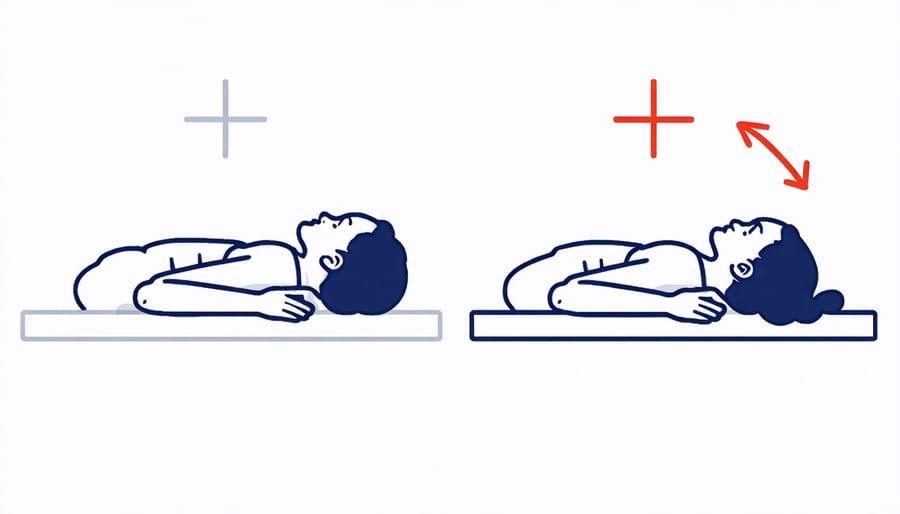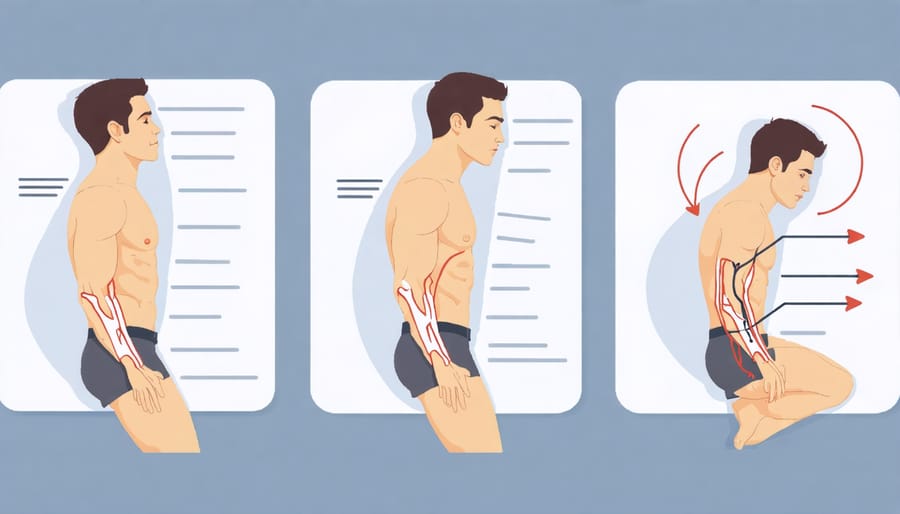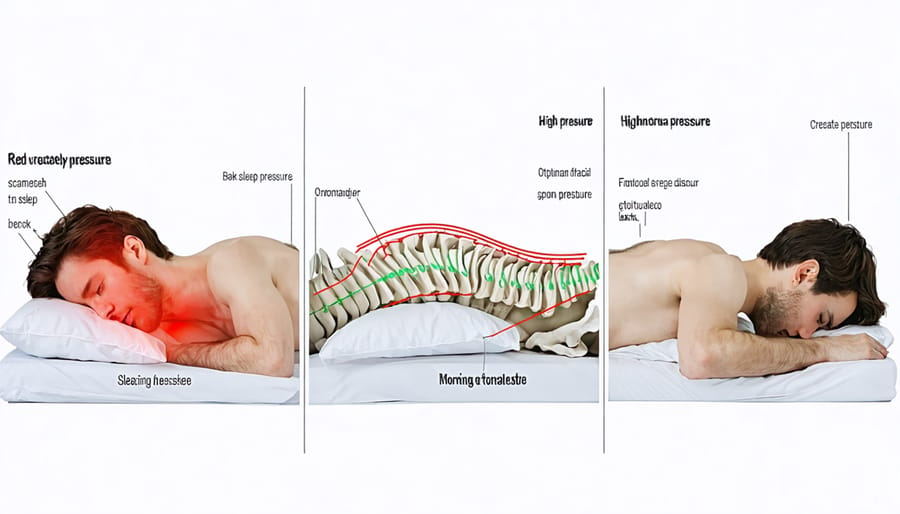Wake up with a stiff neck and throbbing morning headaches? Your sleep posture could be the hidden culprit. Poor neck alignment during sleep triggers muscle tension and nerve compression, creating a cascade of pain that affects millions of Canadians each year. While occasional sleep-related headaches are common, chronic morning head pain signals the need for immediate posture correction. Understanding the connection between sleep position and headache development empowers you to make simple yet effective changes to your nighttime routine. From choosing the right pillow height to maintaining proper spine alignment, small adjustments to your sleeping position can dramatically reduce head pain and improve your overall sleep quality. The good news? Most sleep posture headaches respond well to practical lifestyle modifications, and relief often begins within days of implementing proper sleep positioning techniques.
Understanding Sleep Posture Headaches
Common Symptoms
Sleep posture headaches typically present themselves immediately upon waking or within the first hour of starting your day. The most common symptom is a dull, pressing pain that often affects one side of the head, though it can occur on both sides. Many people describe the sensation as feeling like a tight band wrapped around their head.
These headaches are usually accompanied by neck stiffness and tenderness in the shoulders. You might notice that the pain intensifies when you move your head or neck in certain directions. Some people also experience mild jaw discomfort or tension in their upper back.
Unlike migraines, sleep posture headaches rarely cause nausea or sensitivity to light and sound. The pain typically improves within 30 minutes to a few hours after getting up and moving around, especially if you engage in gentle stretching or maintain good posture throughout the day.
A key identifying feature is that these headaches tend to be most severe in the morning and gradually improve as the day progresses. If you find yourself waking up with headaches more than twice a week, it’s likely that your sleep posture may be the culprit.
How Sleep Position Affects Your Head and Neck
Your sleep position plays a crucial role in how your head and neck are supported throughout the night. When you sleep, your spine should maintain its natural curve, with your head and neck properly aligned. However, certain positions can disrupt this alignment, leading to muscle strain and tension headaches.
Side sleeping is generally considered optimal, as it helps maintain proper spinal alignment. When done correctly, with a supportive pillow that fills the space between your shoulder and head, this position keeps your neck neutral. However, using a pillow that’s too high or too low can force your neck to bend unnaturally.
Back sleeping can be beneficial if you use the right pillow support. Your head should rest in a neutral position, with your chin neither tucked too far down nor tilted too far back. A pillow that’s too thick can push your head forward, while one that’s too thin might let it fall back, both potentially causing neck strain.
Stomach sleeping often causes the most problems for head and neck alignment. This position requires you to turn your head to one side for extended periods, which can strain neck muscles and compress nerves. It also typically arches your lower back, creating additional stress on your spine.
The biomechanics of sleep posture directly affect the tension in your neck muscles and the pressure on your nerves, which can trigger morning headaches. Making adjustments to achieve proper alignment can significantly reduce your risk of waking up with head and neck pain.


Problem Sleep Positions That Cause Headaches
Side Sleeping Issues
While side sleeping is generally considered a healthy position, it can contribute to headaches if not properly supported. Common issues include neck strain from pillows that are too high or too low, shoulder compression from poor arm positioning, and spinal misalignment. To address these problems, choose a pillow that keeps your head and neck aligned with your spine – typically one that’s about 4-6 inches thick. Place a small pillow between your knees to maintain proper hip alignment, and ensure your mattress provides adequate support to prevent your body from sinking unevenly. Switching sides regularly can help prevent muscle imbalances, and keeping your arms relaxed rather than tucked under your pillow can reduce shoulder and neck tension that may lead to headaches.
Back Sleeping Challenges
While sleeping on your back is often recommended for proper spinal alignment, it can present challenges for some individuals. Common issues include increased snoring and sleep apnea due to relaxed throat muscles, difficulty breathing, and potential neck strain if your pillow doesn’t provide adequate support. Some people also experience acid reflux symptoms when lying flat on their back.
To address these challenges, try elevating your head slightly with a supportive pillow that maintains proper neck alignment. A wedge pillow can help reduce acid reflux and breathing difficulties. If snoring is an issue, consider sleeping with your head elevated at a 30-degree angle. For those who find back sleeping uncomfortable, gradually transition by starting with short periods and using supportive pillows along your sides to prevent rolling over.
Remember that while back sleeping has benefits, the most important factor is finding a comfortable position that allows quality sleep without causing pain or discomfort.
Stomach Sleeping Risks
Sleeping on your stomach can significantly increase your risk of developing headaches due to the awkward neck position this posture requires. When you lie face-down, your head must turn to one side to breathe, creating prolonged neck rotation and muscle strain. This misalignment puts excessive pressure on your cervical spine and can compress nerves and blood vessels, leading to morning headaches.
To minimize these risks, consider transitioning to side or back sleeping positions. If you must sleep on your stomach, use a very thin pillow or no pillow at all to reduce neck strain. Some people find success with specialized stomach sleeper pillows that have a curved design to support better spinal alignment. Making gradual adjustments to your sleep position and using supportive pillows can help prevent posture-related headaches while ensuring you get restful sleep.
Practical Solutions for Better Sleep Posture
Choosing the Right Pillow
Choosing the right pillow is crucial for preventing sleep posture headaches. For back sleepers, select a medium-height pillow that keeps your head and neck aligned with your spine. The pillow should fill the natural curve of your neck without pushing your head too far forward.
Side sleepers need a firmer, higher pillow to maintain the space between their ear and shoulder. Look for pillows specifically designed for side sleeping, which help keep your spine straight and prevent neck strain.
Stomach sleepers should opt for very thin, soft pillows or consider sleeping without one to minimize neck rotation. If you must use a pillow, choose one that’s relatively flat and places minimal stress on your neck.
Consider materials carefully – memory foam provides excellent support and conforms to your head shape, while latex offers similar benefits with better temperature regulation. Replace your pillow when it loses shape or support, typically every 1-2 years, to maintain proper sleep posture and prevent headaches.

Mattress Considerations
Your choice of mattress plays a crucial role in how your mattress affects sleep posture and potential headache development. A mattress that’s too firm or too soft can force your spine into an unnatural alignment, leading to neck strain and morning headaches. Medium-firm mattresses typically provide the best support for most sleepers, maintaining proper spinal alignment while offering enough cushioning for pressure points.
Consider replacing your mattress if it’s more than 8 years old or shows visible sagging. Memory foam and latex mattresses can be particularly beneficial as they conform to your body’s natural curves while providing consistent support. If purchasing a new mattress isn’t possible, a high-quality mattress topper can help improve support and alignment. Remember to rotate your mattress regularly to prevent uneven wear and maintain its supportive properties.
Nighttime Stretches and Exercises
Before bed, take a few minutes to perform these gentle exercises to release tension and promote better sleep posture. Start with neck rolls: slowly rotate your head in circles, five times in each direction. Follow with shoulder shrugs, lifting your shoulders toward your ears, holding for three seconds, then releasing.
To target upper back tension, try the cat-cow stretch while sitting on the edge of your bed. Arch your back while looking up, then round it while looking down. Repeat 10 times. A gentle chest stretch can help counteract forward head posture: clasp your hands behind your back and gently lift your arms while squeezing your shoulder blades together.
Finally, lie on your back with a small pillow under your neck. Slowly turn your head from side to side, holding each position for 10 seconds. This helps align your spine and releases neck tension. Remember to perform these exercises slowly and stop if you feel any pain or discomfort.
Understanding and addressing sleep posture headaches can significantly improve your quality of life. By making simple adjustments to your sleeping position, choosing the right pillow, and maintaining proper spine alignment, you can reduce or eliminate these morning headaches. Remember that good sleep posture isn’t just about comfort—it’s an essential component of your overall health and well-being. Start implementing these changes gradually, and pay attention to how your body responds. If your headaches persist despite these modifications, don’t hesitate to consult a healthcare provider. With consistent attention to your sleep posture and the right support, you can wake up feeling refreshed and pain-free, ready to embrace each new day.

